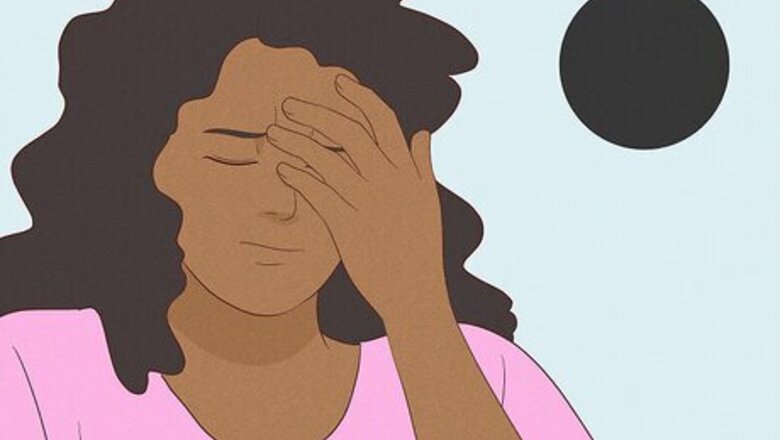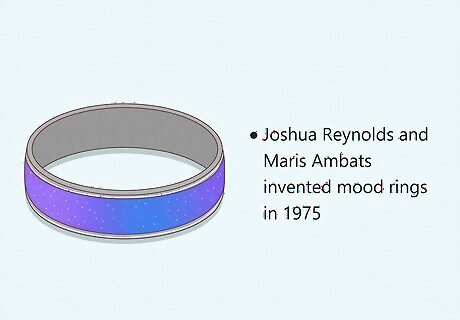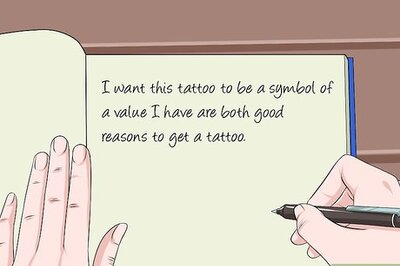
views
Mood Ring Colors and Meanings

Black A black mood ring typically symbolizes feeling tense, nervous, overworked, depressed, or stressed. With that being said, don’t panic if your mood ring turns black. It can also be a sign that your fingers might be a little too cold for your ring to pick up any other color.

Gray A gray mood ring might mean you’re feeling strained, anxious, or nervous about something. If your stress level heightens, this might cause your mood ring to turn black. Take deep breaths and remember that everything is going to be okay!

White White can indicate frustration, confusion, or boredom. If you see this color on your mood ring, it may be a sign to take a break from whatever you’re working on and engage in an activity you enjoy to recharge.

Brown If your mood ring turns brown, it could be a sign you’re feeling restless or full of anticipation or nervous thoughts. Take a moment to think about what’s setting you on edge. If you’re nervous because of an upcoming deadline or event, try taking a short walk outside.

Red When a mood ring turns red, it means your heart rate is more elevated. This color is a sign of high energy, whether you’re feeling romantic passion or anger. If you’re trying to keep your temper in check, visualize yourself somewhere relaxing, like on a beach or in the forest, or repeat a calming phrase, like “It’s all going to be okay.”

Pink Pink is the color of uncertainty, arousal, or interest. You might have just seen a hot person walk by, or you’re trying to make a decision about which path to take next. Either way, remember to be confident in yourself. You’ve got this!

Orange An orange mood ring means that you’re feeling eager to try something new and exciting. Whether you’ve always wanted to skydive, write a book, or try a new diet, this might be a sign to finally do the research and plan to try it this week.

Yellow When your mood ring turns yellow, it means you’re in a creative headspace or feeling spaced out. Put that energy to work by engaging in a creative activity, whether it’s painting, writing, gardening, dancing, or making finger puppets.

Amber or gold This color often looks a little bit darker than yellow, but not dark enough to turn brown. Amber or gold could mean you’re feeling nervous, surprised, or upset. If you’re feeling any of these emotions, try writing down your feelings or doing activities that put you in a brighter mood. You could watch a TV show you enjoy, play video games, go on a nature hike, read a book, or go see a new movie at a theater.

Green From envy to nature and growth, the color green can mean a lot of different things. However, if you see it on a mood ring, it means you’re feeling calm, comfortable, and in a good place, both physically and emotionally. You’re not feeling any stress and are ready to face whatever life throws your way!

Blue-green A bluish-greenish color can indicate that you’re content, peaceful, or relaxed. This doesn’t mean your guard is completely down, but it means you’re motivated, thinking deeply, and free from any tension or anxiety.

Blue Blue is the color of the sea and the sky. When you see it on your mood ring, it means you’re feeling relaxed, fun, happy, and social. You might be feeling more connected to your spiritual side, feeling serene, and focused on connecting to the people around you.

Dark blue Dark blue is often related to feelings of love or romance. Your happy, peaceful mood has shifted to a higher and deeper level, opening you up to flirty conversations and passionate situations.

Purple Purple often symbolizes intuition, psychic vision, and clarity. It’s no surprise that a deep purple mood ring means you’re feeling passionate, excited, very happy, and full of purpose. Now’s the time to take the steps to achieve your goals and put your entire heart into your hobbies.
History of Mood Rings

Joshua Reynolds and Maris Ambats invented mood rings in 1975. Reynolds was a retired stockbroker who came up with the first mood ring design. Silver-plated mood rings sold for around $45, while gold rings sold for $250. Whether or not they were accurate, mood rings quickly became a popular fad that are still made today. Reynolds made over $20 million in his first year but declared bankruptcy a year later when other cheaper mood rings flooded the market. He later went on to design the ThighMaster.
How do mood rings change color?

Mood rings contain liquid crystals that respond to changes in temperature. Modern mood rings work because they contain thermochromic pigments (substances that change color in response to temperature) that combine various temperature ranges. When you put on a mood ring, the crystals inside react to your body temperature, twisting wavelengths of light into different colors. In a neutral emotional state at the normal body temperature (98.6℉ or 37℃), the crystals don’t twist and naturally reflect a blue/green color. Old mood rings were highly susceptible to water damage and high temperatures. They would often lose their ability to change color, turning black instead.
Are mood rings accurate?

Mood rings aren’t accurate emotional predictors, but they’re fun to wear! Body temperature changes are associated with changes in emotions, which does give some scientific backing to mood rings. For example, stress tends to decrease the blood flow (and therefore heat) to your feet and hands. However, other factors would be needed to accurately predict your mood. Body temperature can also change due to other factors than emotion, like being in extremely hot or cold environments or releasing heat due to exercise. Different areas of your body may show different moods. For example, mood necklaces can show a different reading than rings because your chest is warmer than your fingers. Because the materials they’re made of have changed, modern rings don’t necessarily follow the same color patterns, and temperatures trigger which colors might vary from ring to ring.




















Comments
0 comment